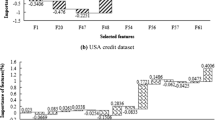Abstract
In this paper, a total least squares (TLS) version of proximal support vector machines (PSVM) is proposed for credit risk evaluation. The formulation of this new model is different from the original PSVM model, so a novel iterative algorithm is proposed to solve this model. A simulation test is first implemented on a classic two-spiral dataset, and then an empirical experiment is conducted on two publicly available credit datasets. The experimental results show that the proposed total least squares PSVM (TLS-PSVM) is at least comparable with PSVM and better than other models including standard SVM model.



Similar content being viewed by others
References
Baesens B, Van Gestel T, Viaene S, Stepanova M, Suykens J, Vanthienen J (2004) Benchmarking state-of-art classification algorithms for credit scoring. J Oper Res Soc 54:627–635
Fawcett T (2006) An introduction to ROC analysis. Pattern Recognit Lett 27:861–874
Frank A, Asuncion A (2010) UCI machine learning repository, University of California Irvine. http://archive.ics.uci.edu/ml
Fu G, and Hu G (2008) Total least square support vector machine for regression. In: Proceedings of the 2008 international conference on intelligent computation technology and automation, vol 1, pp 271–275
Fung G, and Mangasarian OL (2001) Proximal support vector machine classifiers. In: Proceedings of international conference of knowledge discovery and data mining, pp 77–86
Golub G (1973) Some modified matrix eigenvalue problems. SIAM Rev 15:318–334
Golub G, and Van Loan C (1980) An analysis of the total least squares problem. SIAM J Numer Anal 17:883–893
Hardle W, Moro RA, Schafer D (2005) Predicting bankruptcy with support vector machines. In: Statistical tools for finance and insurance. Springer, Berlin, pp 225–248
Levenberg K (1944) A method for the solution of certain non-linear problems in least squares. Q Appl Math 2:164–168
Markovsky I, Van Huffel S (2007) Overview of total least-squares methods. Signal Process 87:2283–2302
Marquardt D (1963) An algorithm for least-squares estimation of nonlinear parameters. SIAM J Appl Math 11:431–441
Mathworks (2008), MATLAB R2008a
Peng X, Wang Y (2009) A normal least squares support vector machine (NLS-SVM) and its learning algorithm. Neurocomputing 72:3734–3741
Rakotomamonjy A (2004) Optimizing area under ROC curve with SVMs, ECAI 04 ROC and Artificial Intelligence Workshop, 20–27 August, Valencia, Spain
Suykens JAK, Vandewalle JV (1999) Least squares support vector machine classifiers. Neural Process Lett 9:293–300
Suykens JAK, van Gestel T, De Brabanter J, De Moor B, and Vandewalle JV (2002) Least squares support vector machines. World Scientific, Singapore
Vapnik V (1995) The nature of statistical learning theory. Springer, New York
Vapnik V (1998) Statistical learning theory. Wiley, New York
Van Gestel T, Suykens JAK, Lanckriet G, Lambrechts A, De Moor B, Vandewalle JV (2002) Bayesian framework for least squares support vector machine classifiers, Gaussian processes and kernel Fisher discriminant analysis. Neural comput 15:1115–1148
Van Gestel T, Baesens B, Garcia J, van Dijcke P (2003) A support vector machine approach to credit scoring. Bank en Financiewezen 2:73–82
Yu L, Wang SY, Lai KK (2009) An intelligent-agent-based fuzzy group decision making model for financial multicriteria decision support: the case of credit scoring. Eur J Oper Res 195:942–959
Yu L, Yao X, Wang S, Lai KK (2011) Credit risk evaluation using a weighted least squares SVM classifier with design of experiment for parameter selection. Expert Syst Appl 38:15392–15399
Zhou LG, Lai KK (2009) Credit scoring models with AUC maximization based on weighted SVM. Int J Inf Technol Decis Mak 8(4):677–696
Acknowledgments
This work is partially supported by grants from the National Science Fund for Distinguished Young Scholars (NSFC No. 71025005) and the National Natural Science Foundation of China (NSFC No. 90924024).
Author information
Authors and Affiliations
Corresponding author
Rights and permissions
About this article
Cite this article
Yu, L., Yao, X. A total least squares proximal support vector classifier for credit risk evaluation. Soft Comput 17, 643–650 (2013). https://doi.org/10.1007/s00500-012-0936-z
Published:
Issue Date:
DOI: https://doi.org/10.1007/s00500-012-0936-z




